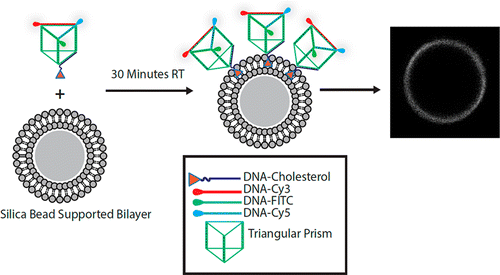当前位置:
X-MOL 学术
›
J. Am. Chem. Soc.
›
论文详情
Our official English website, www.x-mol.net, welcomes your
feedback! (Note: you will need to create a separate account there.)
Dynamic Behavior of DNA Cages Anchored on Spherically Supported Lipid Bilayers
Journal of the American Chemical Society ( IF 14.4 ) Pub Date : 2014-09-08 , DOI: 10.1021/ja506095n J. W. Conway 1 , C. Madwar 1 , T. G. Edwardson 1 , C. K. McLaughlin 1 , J. Fahkoury 1 , R. B. Lennox 1 , H. F. Sleiman 1
Journal of the American Chemical Society ( IF 14.4 ) Pub Date : 2014-09-08 , DOI: 10.1021/ja506095n J. W. Conway 1 , C. Madwar 1 , T. G. Edwardson 1 , C. K. McLaughlin 1 , J. Fahkoury 1 , R. B. Lennox 1 , H. F. Sleiman 1
Affiliation

|
We report the anchoring of 3D-DNA-cholesterol labeled cages on spherically supported lipid bilayer membranes (SSLBM) formed on silica beads, and their addressability through strand displacement reactions, controlled membrane orientation and templated dimerization. The bilayer-anchored cages can load three different DNA-fluorophores by hybridization to their "top" face (furthest from bilayer) and unload each of them selectively upon addition of a specific input displacement strand. We introduce a method to control strand displacement from their less accessible "bottom" face (closest to the bilayer), by adding cholesterol-substituted displacing strands that insert into the bilayer themselves in order to access the toehold region. The orientation of DNA cages within the bilayer is tunable by positioning multiple cholesterol anchoring units on the opposing two faces of the cage, thereby controlling their accessibility to proteins and enzymes. A population of two distinct DNA cages anchored to the SSLBMs exhibited significant membrane fluidity and have been directed into dimer assemblies on bilayer via input of a complementary linking strand. Displacement experiments performed on these anchored dimers indicate that removal of only one prism's anchoring cholesterol strand was not sufficient to release the dimers from the bilayer; however, removal of both cholesterol anchors from the dimerized prisms via two displacement strands cleanly released the dimers from the bilayer. This methodology allows for the anchoring of DNA cages on supported lipid bilayers, the control of their orientation and accessibility within the bilayer, and the programmable dimerization and selective removal of any of their components. The facile coupling of DNA to other functional materials makes this an attractive method for developing stimuli-responsive protein or nanoparticle arrays, drug releasing biomedical device surfaces and self-healing materials for light harvesting applications, using a highly modular, DNA-economic scaffold.
中文翻译:

锚定在球形支撑脂质双层上的 DNA 笼的动态行为
我们报告了 3D-DNA-胆固醇标记笼在硅胶珠上形成的球形支撑脂质双层膜 (SSLBM) 上的锚定,以及它们通过链置换反应、受控膜取向和模板化二聚化的可寻址性。双层锚定笼可以通过与它们的“顶”面(距离双层最远)杂交来加载三种不同的 DNA 荧光团,并在添加特定的输入置换链后选择性地卸载它们中的每一个。我们引入了一种方法,通过添加胆固醇取代的置换链,这些置换链插入双层本身,以便进入立足点区域,从而控制从其不易接近的“底”面(最接近双层)的链置换。双层内 DNA 笼的方向可通过将多个胆固醇锚定单元定位在笼的相对两个面上来调节,从而控制它们对蛋白质和酶的可及性。锚定在 SSLBM 上的两个不同 DNA 笼的群体表现出显着的膜流动性,并通过输入互补连接链被引导到双层上的二聚体组件中。对这些锚定二聚体进行的置换实验表明,仅去除一个棱柱的锚定胆固醇链不足以从双层中释放二聚体;然而,通过两条置换链从二聚棱镜中去除两个胆固醇锚,干净地从双层中释放了二聚体。这种方法允许将 DNA 笼固定在支持的脂质双层上,控制它们在双层内的方向和可及性,以及它们的任何成分的可编程二聚化和选择性去除。DNA 与其他功能材料的轻松耦合使其成为开发刺激响应蛋白或纳米颗粒阵列、药物释放生物医学设备表面和用于光收集应用的自愈材料的有吸引力的方法,使用高度模块化的 DNA 经济支架。
更新日期:2014-09-08
中文翻译:

锚定在球形支撑脂质双层上的 DNA 笼的动态行为
我们报告了 3D-DNA-胆固醇标记笼在硅胶珠上形成的球形支撑脂质双层膜 (SSLBM) 上的锚定,以及它们通过链置换反应、受控膜取向和模板化二聚化的可寻址性。双层锚定笼可以通过与它们的“顶”面(距离双层最远)杂交来加载三种不同的 DNA 荧光团,并在添加特定的输入置换链后选择性地卸载它们中的每一个。我们引入了一种方法,通过添加胆固醇取代的置换链,这些置换链插入双层本身,以便进入立足点区域,从而控制从其不易接近的“底”面(最接近双层)的链置换。双层内 DNA 笼的方向可通过将多个胆固醇锚定单元定位在笼的相对两个面上来调节,从而控制它们对蛋白质和酶的可及性。锚定在 SSLBM 上的两个不同 DNA 笼的群体表现出显着的膜流动性,并通过输入互补连接链被引导到双层上的二聚体组件中。对这些锚定二聚体进行的置换实验表明,仅去除一个棱柱的锚定胆固醇链不足以从双层中释放二聚体;然而,通过两条置换链从二聚棱镜中去除两个胆固醇锚,干净地从双层中释放了二聚体。这种方法允许将 DNA 笼固定在支持的脂质双层上,控制它们在双层内的方向和可及性,以及它们的任何成分的可编程二聚化和选择性去除。DNA 与其他功能材料的轻松耦合使其成为开发刺激响应蛋白或纳米颗粒阵列、药物释放生物医学设备表面和用于光收集应用的自愈材料的有吸引力的方法,使用高度模块化的 DNA 经济支架。


















































 京公网安备 11010802027423号
京公网安备 11010802027423号